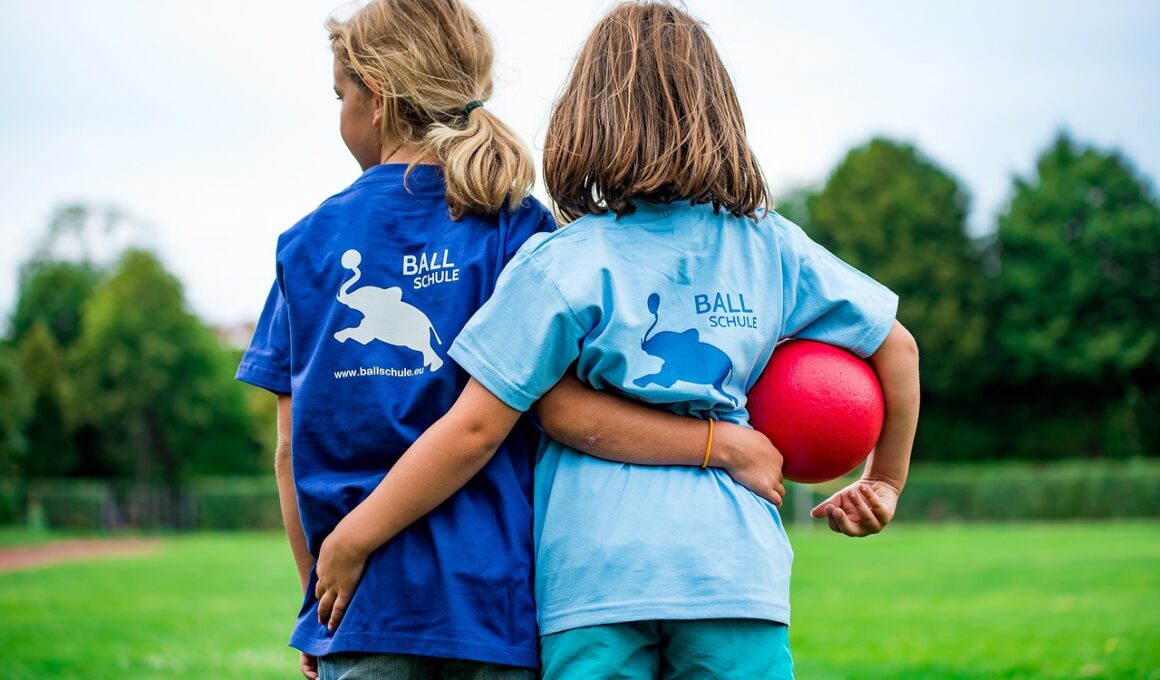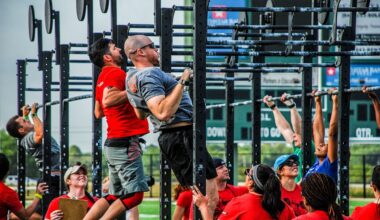The Role of Core Muscles in Children’s Posture and Balance
Core muscles play a vital role in children’s overall health, particularly in terms of posture and balance. For kids, developing a strength base through their core can significantly influence their physical development. Strengthening core muscles involves exercises that engage the abdominal muscles, back muscles, and postural muscles. When these muscles are robust, they provide a stable foundation for many activities, from sports to everyday movements. This stability can help improve their performance in physical education and recreational sports. A strong core also supports proper alignment, which enhances a child’s posture, reducing the risk of injuries or chronic conditions as they grow. Furthermore, a strong core promotes better breathing and overall body coordination. Engaging them in fun activities can motivate children to strengthen these muscles. For parents, implementing core training exercises into their routines means fostering both fun and functional fitness. Child-friendly activities can include climbing, gymnastics, and games that require balance. Overall, addressing core strength in kids is essential for establishing a strong foundation for lifelong health.
Core training for kids cannot be overstated, as it has far-reaching implications for their physical performance. When a child possesses a strong core, they tend to exhibit enhanced balance and coordination. These skills are not just crucial for athletes but are fundamental in everyday life tasks. Children with solid core muscles can maintain their balance while participating in various activities, such as riding bikes or playing on playgrounds. Poor core strength can lead to awkward movements and unstable postures, potentially resulting in injuries. Therefore, developing core strength helps children engage in physical activities more effectively and safely. Parents should encourage a variety of exercises that strengthen the core. Fun and challenging activities like yoga, martial arts, and team sports are excellent for this purpose. Incorporating these exercises into daily routines can equip kids with the required strength and stability. Strengthening the core also supports their spine and pelvis during growth spurts, leading to better posture in the long run. Encouragement from parents can transform core training into an enjoyable yet purposeful experience for children, ensuring that they gain the most from their activities.
Benefits of Core Training in Children
Core training yields numerous benefits that extend beyond just physical performance. For instance, a strong core can positively impact a child’s confidence and aesthetic awareness. As they engage in core-strengthening activities, children may notice improvements in their body stability and posture. This, in turn, fosters a positive body image and self-esteem. Significantly, children who are confident in their physical abilities are likely to engage more with their peers during play and sports, enhancing social skills. In addition to physical and psychological benefits, strong core muscles contribute to improved athletic skills. Kids with strong core muscles can execute sports skills with better precision and strength, like jumping, pitching, or kicking. The integration of balance training using core exercises can improve their reaction times in various sports, giving them a competitive edge. Moreover, core training can reduce the risk of injuries during physical activities. As children learn to control their movements, they develop proprioception, which helps them understand where their bodies are in space. Overall, benefits from core training can create a well-rounded foundation for children’s physical well-being and cognitive development.
Incorporating core training into children’s routines should be engaging and fun rather than a chore. This can be achieved through games, playful activities, and creative challenges that pique their interest. Parents and educators can use tools like stability balls, resistance bands, and interactive sessions to make core workouts more exciting. Activities that incorporate jumping, climbing, and even dancing effectively engage core muscles. Moreover, the inclusion of family or groups for these activities will bolster motivation and adherence. Taking part in a class or team can also promote teamwork, helping kids feel connected to their peers. Children are more likely to stick with routines that feel enjoyable, fostering a positive habit towards fitness for the future. Ensuring that the training comprises various activities will keep kids engaged in the process. With diverse exercises, kids will develop a broader range of muscle strength and balance skills. Thus, creativity in structuring these sessions can lead to long-lasting physical benefits. Regular core exercises can also interconnect with routine activities, where parents involved in playful competition encourage and instill positive habits.
Age-Appropriate Core Exercises
Choosing age-appropriate exercises is crucial for effective core training in children. The appropriateness ensures safety while targeting the core muscles efficiently. For younger children, bodyweight exercises such as planks, bridges, and modified squats can readily develop foundational strength. These exercises can be implemented into playtime, cleverly disguising them as games. Simple movements like crawling, rolling, and balancing tasks are great for toddlers and preschoolers. As children grow and mature, more structured exercises can be introduced. Executing core workouts alongside dynamic movements like jumping or running fosters more complex coordination. Activities such as obstacle courses simulate real-life challenges that effectively engage the core while improving agility and balance. Ensuring that exercises remain multi-dimensional can aid in reinforcing learning while having fun. For older children, integrating sport-specific core training can help them excel in their chosen activities. Sports like gymnastics, soccer, and hockey benefit immensely from a specialized core training routine, which emphasizes strength and flexibility. Therefore, core training needs to be tailored to the child’s developmental level, ensuring continued engagement and growth.
Lastly, guidance from health professionals or fitness experts can enhance core training programs for children. This expertise can confront potential hazards, ensuring proper techniques and injury prevention. Understanding a child’s capabilities and limitations is essential to create a safe, effective program. Parents can collaborate with trainers to develop customized core training regimes that suit their children’s unique needs. Regular evaluations can guide modifications and allow for progressive challenges. Keeping children safe while encouraging them to reach new fitness heights is paramount. Furthermore, psychological support from trained professionals can help address any fears or apprehensions children have about physical activity. Building an environment of trust can motivate kids to be more adventurous in their pursuits, fostering positive experiences. Ultimately, with the right support and educational resources, a child’s core training can promote lasting health benefits. Children learn the importance of physical fitness, grace, and coordination, enhancing their overall quality of life. Long-term, this foundation can help guide them toward healthier lifestyle choices throughout their adult years. Therefore, prioritizing core training early on paves the way for success.
Conclusion
In conclusion, core training is vital in developing children’s posture and balance. By fostering strong core muscles, children can improve their performance in physical activities while maintaining balance and stability. The psychological benefits of core strength contribute to increased self-esteem and confidence levels. With the support of parents, educators, and specialists, children can engage in enjoyable and effective core training that suits their age and individual needs. Also, with the increased importance of fitness in an ever-evolving physical landscape, early exposure to core training can guide children toward healthier lifestyles. Creativity and engagement should steer these activities, making fitness enjoyable rather than tedious work. Thus, strategically incorporating core training in children’s routines can help them develop strong foundations for physical prowess. Regularly provided fun exercises not only help children stay active but also build essential skills and resilience for a lifetime. Ultimately, improving children’s core strength doesn’t just prepare them for physical challenges but equips them with confidence exercising their abilities. The benefits seen today will resonate for years, establishing a legacy of fitness that nurtures health and wellness through every stage of life.
Core training plays a substantial role in children’s physical development by emphasizing the importance of posture and balance. In a world where technology often seduces kids to remain sedentary, it’s crucial to encourage physical activity integrated with core workouts, such as jumping games. Developing a strong core isn’t merely about aesthetics; it primarily supports functional movements. Activities like climbing or sports benefit immensely from strong core stability, allowing kids to perform tasks efficiently. Notably, the benefits of core strength extend beyond childhood, establishing healthy habits for adult life. Introducing children to core exercises also encourages social connections and teamwork, as many activities are best performed in groups or pairs. Parents can plan family outings focusing on physical activities that target the core, reinforcing bonding time while working towards fitness. Additionally, the incorporation of core-based games fosters interest and excitement, making it easier for children to adhere to such routines. Ultimately, cultivating awareness about core strength early on enhances children’s overall experiences in sports and recreational activities, leading to balanced physical development. The lifelong advantages of having strong core muscles will empower them to remain confident and active throughout their lives.


